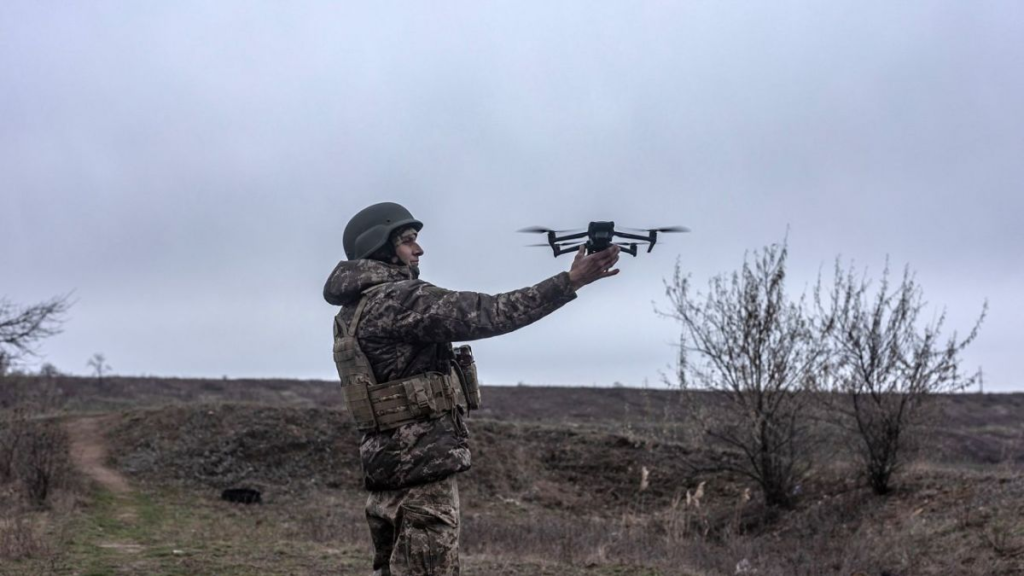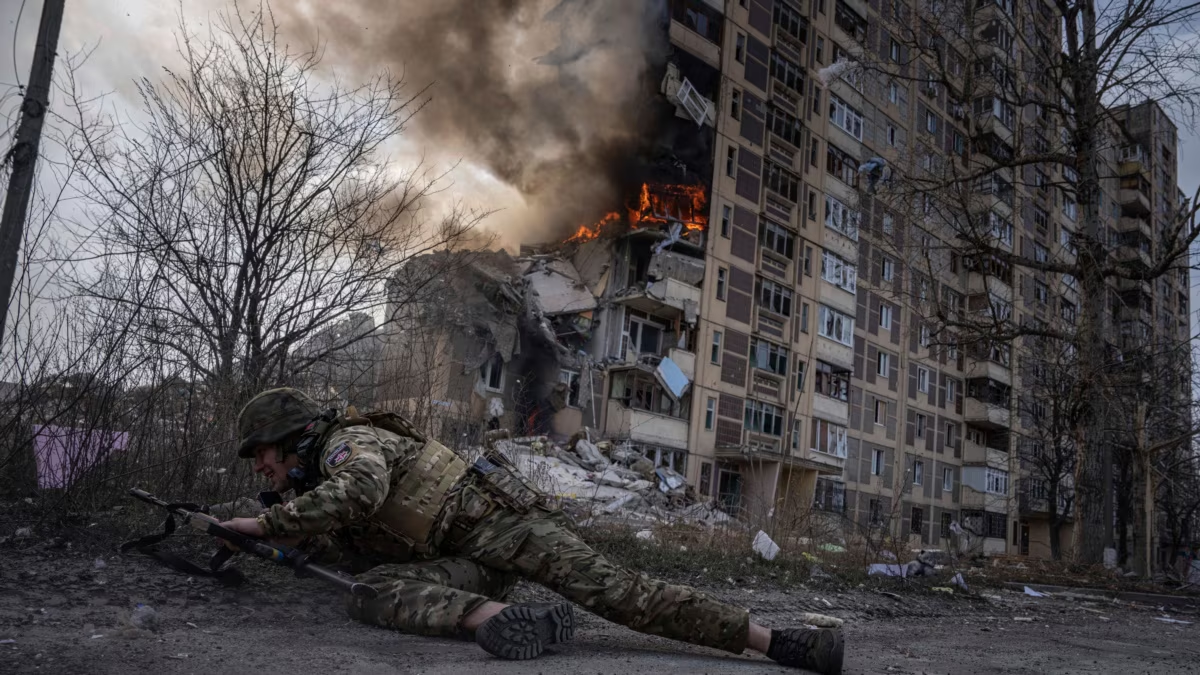In the midst of an intense conflict between Ukraine and Russia, Kyiv launched more than 100 drones over western Russia, responding to a missile attack that left 17 people injured in Ukraine’s Kryvyi Rih. The missile strike further escalated a war that has been marked by destruction and ongoing aerial assaults from both sides.
The Ukrainian drone barrage and Russia’s retaliation continue to illustrate the high-stakes nature of the ongoing war, which shows no sign of easing.
Ukrainian Drone Offensive: A New Dimension in the Conflict
The drone offensive launched by Ukraine represents a significant escalation in the war, as large-scale aerial attacks over Russian territories have been relatively rare, even after two and a half years of fighting. The attack reportedly targeted seven regions of Russia, with a total of 110 drones being deployed overnight.
The Kursk region, located near the Ukrainian border, was one of the main areas hit, with 43 drones reportedly intercepted by Russian air defenses.
One of the most notable targets was the city of Dzerzhinsk, located in the Nizhny Novgorod region, home to a key explosives manufacturing facility. Social media footage from the region appeared to capture the city’s air defenses at work, engaging in an attempt to repel the drone attack.
Read : North Korea Sends 1,500 Soldiers to Help Russia in Ukraine War
Local authorities confirmed that four firefighters were injured during the incident. The drone attack raised alarms due to its proximity to the Sverdlov factory, a state-owned facility known for producing chemical components used in artillery ammunition and bombs.
Ukraine’s military acknowledged that the factory had been a specific target, citing its role in supplying Russia’s war machine with critical munitions. Furthermore, a military airfield in Russia’s Lipetsk region was also struck by a drone, resulting in a fire.
Read : NATO Members Pledge 40 Billion Euros in Military Aid for Ukraine in Washington Summit
These developments underline the increasing use of drones by Ukraine, as both a means of direct attack and psychological warfare, forcing Russia to invest further in defending its airspace.
This drone offensive echoes a similar Ukrainian attack at the end of September, where the Russian Ministry of Defense reported that 125 drones had been launched against seven regions.
The increasing frequency of these attacks suggests that Ukraine has developed more sophisticated capabilities in drone warfare, aiming to strike at the heart of Russian military and industrial infrastructure.
Missile Strikes in Kryvyi Rih: Civilian Impact of the War
While the Ukrainian drone offensive was causing alarm in Russia, the missile strikes launched by Russia against the Ukrainian city of Kryvyi Rih highlighted the continued suffering of civilians in this drawn-out war.
Two Russian ballistic missiles hit the city, causing significant damage to homes and businesses, and leaving 17 people injured. The attack occurred late Saturday evening, according to local officials, further illustrating Russia’s strategy of targeting civilian infrastructure to weaken Ukraine’s resolve.

The ballistic missile strikes were part of a broader Russian campaign of aerial bombardment. Ukraine’s air force reported that Russia had launched a total of 49 drones and two Iskander-M ballistic missiles overnight. While Ukraine was able to intercept 31 of the drones, the missile strikes took a heavy toll on civilian areas, further contributing to the growing devastation in Ukraine’s cities.
The Ukrainian military also noted that some of the drones were neutralized through electronic countermeasures, but the damage caused by the remaining projectiles highlighted the continued vulnerability of Ukraine’s civilian infrastructure.
The strikes on Kryvyi Rih are just the latest in a series of Russian attacks on Ukrainian cities. President Volodymyr Zelenskyy, in a social media post, emphasized that these attacks were part of a larger pattern of “deliberate terror” by Russia.
He noted that, over the past week alone, Russia had launched 800 guided aerial bombs and more than 500 attack drones against Ukraine. These figures underscore the sheer scale of the Russian aerial campaign, which has led to widespread destruction in urban areas and caused untold suffering for the civilian population.
The Ongoing Need for International Support
As both Ukraine and Russia continue to escalate their use of drones and missiles, it is clear that air superiority and the ability to defend against aerial assaults have become central to the conflict.
Ukrainian President Zelenskyy reiterated his calls for continued air support from Ukraine’s international allies, emphasizing that the country’s ability to defend itself from Russian attacks depends heavily on external aid.
Zelenskyy framed the conflict as a broader struggle between the world and Russian “terror,” calling for united global action to resist Moscow’s military tactics. His plea for further military assistance comes as Ukraine’s air defenses have become increasingly strained under the weight of the constant barrage of drones and missiles from Russia.
The president’s remarks reflect the ongoing strategic importance of Ukraine’s alliances with Western powers, particularly as the country continues to rely on foreign weaponry and equipment to sustain its military operations.

In the past, Western nations, including the United States and members of the European Union, have provided significant support to Ukraine, including advanced air defense systems, drones, and other military equipment. However, as the conflict continues to evolve, with both sides deploying more advanced weaponry, the need for further assistance has only grown.
Ukraine’s capacity to launch such a large-scale drone attack against Russia suggests that it has benefited from significant external support in developing its drone warfare capabilities, but the country remains vulnerable to Russian retaliation.
Zelenskyy’s call for unity in the face of Russian aggression also reflects the broader geopolitical dimensions of the war. As Russia continues its campaign against Ukraine, the conflict has increasingly drawn in external actors, with Western nations providing aid to Ukraine and countries like Iran reportedly supplying drones to Russia.
This internationalization of the conflict has made it even more complex, with both sides relying on foreign technology and support to sustain their military efforts.
The drone attacks and missile strikes in recent days serve as a stark reminder of the ongoing devastation caused by the war. While Ukraine’s drone offensive has demonstrated its ability to strike deep into Russian territory, the suffering of civilians in cities like Kryvyi Rih highlights the human cost of the conflict.
As both sides continue to escalate their use of drones and missiles, the war shows no sign of abating, and the need for international diplomatic efforts to bring about a resolution becomes ever more urgent.
The war between Ukraine and Russia has entered a new phase marked by increasingly sophisticated aerial attacks from both sides. The Ukrainian drone offensive against Russia represents a significant escalation, demonstrating Kyiv’s growing capabilities in drone warfare.
Meanwhile, the missile strikes on Kryvyi Rih illustrate the continued toll of the war on Ukraine’s civilian population. As both countries ramp up their military efforts, the need for continued international support for Ukraine, both in terms of military aid and diplomatic efforts, remains critical to achieving a peaceful resolution to the conflict.
let’s enjoy few years on earth with peace and happiness….✍🏼🙏

